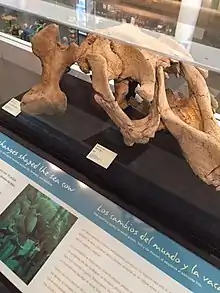Cuesta sea cow
The Cuesta sea cow (Hydrodamalis cuestae) is an extinct herbivorous marine mammal, and the direct ancestor of the Steller's sea cow (Hydrodamalis gigas). They reached up to 9 metres (30 ft) in length, making them among the biggest sirenians to have ever lived. They were first described in 1978 by Daryl Domning when fossils in California were unearthed. Its appearance and behavior are largely based on that of the well-documented Steller's sea cow, which, unlike the Cuesta sea cow, lived into modern times and was well-described.
| Cuesta sea cow | |
|---|---|
 | |
| Skull of Hydrodamalis cuestae at San Diego Natural History Museum | |
| Scientific classification | |
| Kingdom: | |
| Phylum: | |
| Class: | |
| Order: | |
| Family: | |
| Subfamily: | |
| Genus: | |
| Species: | †H. cuestae Domning, 1978 |
| Synonyms | |
|
?†H. spissa Furusawa, 1988 | |
Taxonomy and extinction
| Relations within Hydrodamalinae | ||||||||||||||||||||||||||||||||||||||||||
| ||||||||||||||||||||||||||||||||||||||||||
| Based on a 2004 study by Hitoshi Furusawa[1] |
The fossils of the Cuesta sea cow were first discovered in the Late Pliocene sediment formations of Pismo Beach, California in 1978, and following finds of the species were unearthed in California.[2] In 1988, fossils of sea cows were discovered in Hokkaido, but were originally assigned to the Takikawa sea cow (H. spissa),[3] a newly described species, but this is thought of by some scientists as a synonym of H. cuestae. It is uncertain whether or not H. spissa was simply a local variant of H. cuestae or a completely separate lineage.[3] The Steller's sea cow was apparently a direct descendant of the Cuesta sea cow.[4]
The Cuesta sea cow went extinct around 2 and a half million years ago. The disappearance of the Cuesta sea cow was likely linked to the onset of the Quaternary glaciation. Its main food source of seagrasses, due to the cooling of the oceans, declined to a point where it could no longer support their population. As well as this, the sea cows themselves were not adapted to the cold, and those that were probably gave rise to the Steller's sea cow.[2]
Biology and behavior
The Cuesta sea cow, like the Steller's sea cow, was probably gregarious and lived in small family groups. The bones were dense and served as a sort of ballast to prevent floating, probably so that they could feed on bottom-dwelling sea grasses. Sea grasses were their preferred food source. They most likely 'walked' along the shallow seafloor using their front limbs, using their powerful tail fin for propulsion. It has been speculated that, like the Steller's sea cows, the front limbs were used as holdfasts. The Cuesta sea cow was among the largest of the sirenians to have ever lived, reaching up to 9 metres (30 ft) in length and possibly 10 tonnes (11 short tons). The body was fusiform, being tapered at both the head and the tail.[2][5]
References
- Furusawa, Hitoshi (2004). "A phylogeny of the North Pacific Sirenia (Dugongidae: Hydrodamalinae) based on a comparative study of endocranial casts". Paleontological Research. 8 (2): 91–98. doi:10.2517/prpsj.8.91.
- Domning, Daryl P. (1978). "An Ecological Model for Late Tertiary Sirenian Evolution in the North Pacific Ocean". Systematic Zoology. 25 (4): 352–362. doi:10.2307/2412510. JSTOR 2412510.
- Furusawa, H. (1988). A new species of hydrodamaline Sirenia from Hokkaido, Japan. Takikawa Museum of Art and Natural History. pp. 1–73.
- Marsh, Helene; O'Shea, Thomas J.; Reynolds III, John E. (2011). "Steller's sea cow: discovery, biology and exploitation of a relict giant sirenian". Ecology and Conservation of the Sirenia: Dugongs and Manatees. New York: Cambridge University Press. pp. 18–35. ISBN 978-0-521-88828-8.
- "Hydrodamalis cuestae" (in Russian). Age of Mammals. 2013. Archived from the original on 17 April 2013. Retrieved 2 September 2016.
